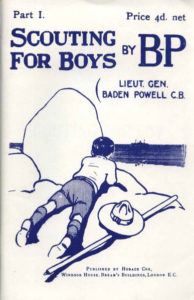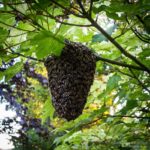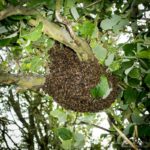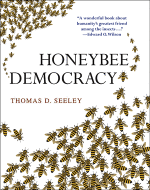Scouting for girls
A swarm of bees is a wonderful sight … if it’s arriving in your bait hive. It’s still dramatic, but perhaps slightly less wonderful, if it’s disappearing over the fence from your apiary 😉
Although some will disagree, I think beekeepers have a responsibility to both control swarming of their own stock, and capture – or attract – swarms lost by others. Although perhaps incomprehensible to us, some don’t share our passion for bees. Many are frightened and a large swarm is an intimidating sight for the melissophobic.
Aside from frightening people, if they move into the church tower or an old hollow tree, they’re likely to develop high levels of Varroa and the pathogenic viruses the mite transmits. As a consequence, they can act as a source of disease to bees in local apiaries, until they’re killed off in the winter. Which they almost certainly will be.
I therefore always put out bait hives in late Spring, well ahead of the expected start of the swarming season (which often coincides with the oil seed rape finishing). I’ve described the basics of bait hives previously – a National-sized, bee-smelling box containing one frame of old, dark comb and half a dozen foundationless frames. I often use stacked supers from the, otherwise-awful, Paradise poly hives for this purpose.
Dyb dyb dyb†
One of the greats sights of the swarming season is the appearance of the first scout bees at the bait hive. First one or two, then a dozen and, within hours or days, hundreds. They check out the entrance and the inside the bait hive. They fly all around the perimeter. They’re unaggressive and you can get up close to watch them at work. If you listen carefully you can hear them pinging into the sidewalls and floor of the bait hive as they move about inside.
They actually probably measure the volume by a combination of walking around the inner walls and determining the mean free path length – the average length of all straight lines from wall-to-wall in the hive – in short flights. For an interesting and easily readable discussion of the physics behind this I recommend the short paper by Nigel Franks and Anna Dornhaus (PDF) How might individual honeybees measure massive volumes?
In my view, this alone is a good reason to use foundationless frames in a bait hive.
Scouts often arrive early at the bait hive and leave late. Their numbers will fluctuate with weather and temperature – they’ll disappear altogether in the rain, but reappear in force once a shower has passed.
Scouting around
This short video was taken about 9am, two or three days before a large prime swarm occupied the bait hive. The first scout bees I’d seen had been almost two weeks previously. By midday there were hundreds of bees checking the hive.
However, if you look closely, their behaviour is distinctively different from a colony ‘in residence’. They’re much more hesitant in entering the hive and they tend to check the immediate environment much more closely. In contrast, foragers returning to a colony don’t bother doing a couple of laps of the hive … they approach directly and enter with minimal delay.
Seeley’s swarms
The definitive guide to how scout bees choose suitable locations and then ‘persuade’ the swarm to relocate is Honeybee Democracy by Tom Seeley. This is an outstanding book, beautifully written and illustrated.
Swarming is a two-stage process. The queen and flying bees leave the hive and settle nearby – on a branch, a fence post or (irritatingly) the top of a nearby conifer – creating the classic ‘beard-shaped’ cluster of bees. If you’re lucky with your timing and their location you can knock these into a box and, voila, you have a new colony.
Tom Seeley describes his own studies (based on the equally elegant work of Martin Lindauer in the 1950’s) that determine how scout bees convince the swarm to move from this temporary staging post to a new nesting location – a tree cavity, the church tower or your bait hive. The scout bees use a variation of the classic waggle dance – on the surface of the swarm hanging in the tree – to ‘persuade’ other scouts to check out the location they’ve found. Through repeated cycles of recruitment and reinforcement a consensus is reached and the scouts then lead the swarm to their new home.
That’s the abridged version. Read the book. There are subtleties and anecdotes throughout Honeybee Democracy that mean it’s the sort of book you can go back to time and time again, learning something new each time.
Early scouts
I was puzzled by the swarm that arrived in my bait hive. The first scouts appeared early in the first week of May. I was abroad from the 7th to the 14th and confidently expected the swarm to be waiting for me when I got back. However, it wasn’t until at least another week had elapsed – during which scout bee interest continued unabated – that the swarm arrived.
I went back to Honeybee Democracy and re-read the second chapter (‘Life in a honeybee colony’) and learnt – or was reminded – that there are early scout bees that are able to judge both nest site quality and the state of the colony preparing to swarm. These scouts are at work before the colony swarms. Uniquely these bees are judging both the availability and suitability of new homes and the readiness of the colony to swarm.
They can also tell whether it’s a nice day. The coincidence of these factors – good weather, readiness of the colony to swarm (i.e. sealed queen cells) and potential nest sites – initiate a behavioural change in these scouts that leads to the colony swarming.
Are these scouts the earliest sign of swarm preparation?
What Seeley doesn’t say is just how early in the swarming cycle these scout bees start their initial explorations.
Queens take 16 days to develop from new-laid eggs to eclosion, and just nine days to the sealing of the queen cell. If we assume that the first scouts I saw were from the same hive that subsequently swarmed (and delivered itself to my bait hive) then these scouts were out and about well-before queen cells were even started.
Of course, I have no way of telling whether the first scouts I saw were from the same colony that finally swarmed and arrived. Nevertheless, it’s an interesting thought. Perhaps scout bee interest in a bait hive pre-dates the first definitive swarm preparation signs beekeepers can usually recognise – the appearance of charged queen cells?
Considering the density of beekeepers (by which I mean apiaries 😉 ) in the UK it’s not easy to see how this would be useful … unless you’re the only beekeeper on an isolated island.
However, if you see do scout bee activity at your bait hives it might be worth being more assiduous than usual when checking your own colonies in the neighbourhood.
† Dyb dyb dyb is an abbreviation for ‘do your best‘. This was part of a cub (not scout) ceremony and was followed by Dob dob dob (‘do our best‘). It was abandoned in the late sixties, but lives on in tricky questions on Qi.
Colophon

Scouting for Boys …
The title of this post is a play on ‘Scouting for Boys‘, the book on Boy Scout training, written and illustrated (originally) by Robert Baden-Powell and published in 1908. The book contains sections on scoutcraft, woodcraft, tracking, camp life, endurance, chivalry, life saving and patriotism. It was the inspiration for the scout movement and Baden-Powell was the founder and first Chief Scout of the Boy Scouts Association (and the founder of the Girl Guides). It is estimated that 4 million copies sold in the UK alone, with global sales in the 20th Century exceeding 100 million.
The book even contains reference to honey bees with the statement that bees form a ‘model community, for they respect their Queen and kill their unemployed’.
The Boy Scouts of America used to offer merit badges in Beefarming (1915-1955) and Beekeeping (from 1955). The Beekeeping merit badge was discontinued in 1995.
Scouting for Girls is an English pop rock band. They have recently announced their 10th Anniversary Tour (Oct/Nov 2017) which means they’re much too new for me to know any of their music 😉



Join the discussion ...